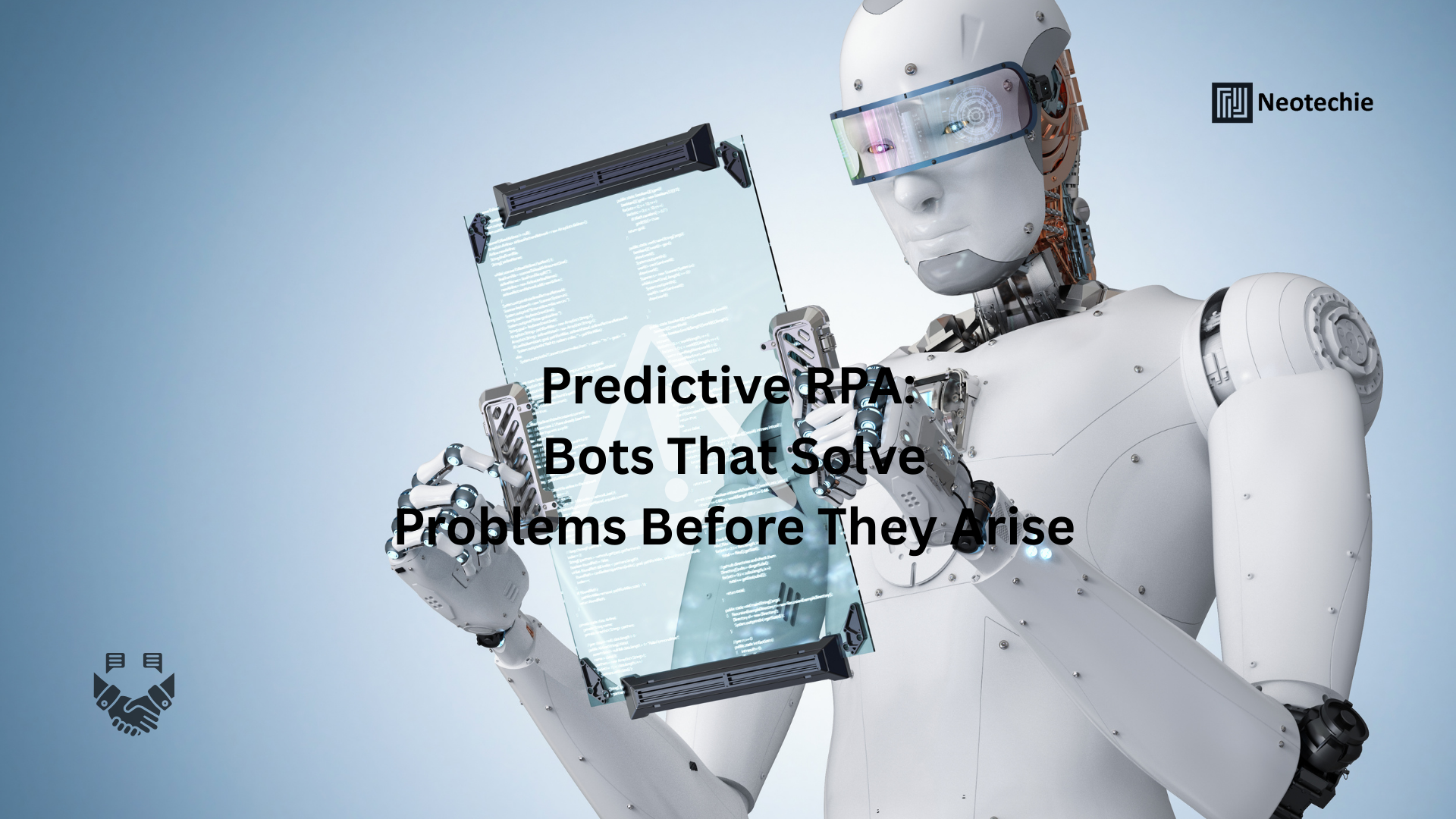Predictive RPA — Bots That Anticipate and Resolve Issues Before They Happen
Moving Beyond Reactive Automation
Traditional RPA focuses on automating repetitive, rule-based tasks, reducing manual effort, errors, and cycle time. While effective, this approach is reactive — bots only act when a process is triggered. In contrast, Predictive RPA leverages machine learning, AI, and analytics to anticipate potential issues, automatically intervene, and prevent disruptions before they impact business operations.
By combining RPA with predictive intelligence, enterprises can transform their digital workforce from a passive executor into a proactive problem-solver, driving efficiency, risk reduction, and operational excellence.
What Predictive RPA Can Do
- Forecasting Operational Bottlenecks
- What: Predictive RPA identifies workflow congestion points, delays, and high-risk steps before they affect operations.
- Why: Bottlenecks in key processes, such as invoice approvals or order fulfillment, can delay business cycles, reduce customer satisfaction, and impact revenue. Early detection is crucial to maintaining seamless operations.
- How: Bots analyze historical process data, monitor real-time task queues, and predict areas of potential delay. They can alert managers or automatically reassign tasks to prevent backlogs. For example, in a logistics operation, if shipping approvals tend to pile up at certain times, bots can proactively redistribute tasks to ensure deadlines are met. This prevents bottlenecks and maintains continuous workflow efficiency.
- Preventive Issue Resolution
- What: Predictive bots can detect recurring process errors and apply corrective actions automatically before human intervention is required.
- Why: Many operational issues, such as invoice mismatches, data entry errors, or system discrepancies, occur predictably. Waiting for manual detection increases correction time and can impact business outcomes.
- How: Using historical data patterns, bots recognize anomalies and implement predefined fixes. For instance, if certain suppliers consistently submit invoices with formatting errors, the bot can auto-correct the entries or flag only exceptions for review. This reduces error propagation, improves accuracy, and minimizes operational risk.
- Dynamic Workload Balancing
- What: Predictive RPA ensures optimal distribution of tasks across bots and human employees.
- Why: Uneven workloads result in idle bots, overworked employees, delayed processes, and lower overall productivity. Predicting workload surges allows proactive adjustment of resources.
- How: Bots monitor task completion times, historical workflow data, and seasonal trends to forecast upcoming workload volumes. They can dynamically reallocate tasks, temporarily assign bots to other high-priority processes, or generate alerts for management action. In banking or insurance claims processing, this ensures that peak submissions are handled without delays, maximizing efficiency and reducing downtime.
- Anomaly Detection in Data and Transactions
- What: Predictive RPA continuously monitors operations to detect deviations from expected behavior in data, transactions, or system activities.
- Why: Early identification of anomalies protects enterprises from financial loss, regulatory violations, and reputational harm. Undetected anomalies can escalate into major operational or compliance issues.
- How: Bots use AI algorithms to detect patterns, flag irregularities, and trigger preventive workflows. For example, unusual payment amounts or unexpected order cancellations are immediately flagged and reviewed. Predictive bots can even auto-initiate corrective steps, such as temporarily halting suspect transactions, thus mitigating risk and maintaining business integrity.
- Predictive Maintenance and IT Support
- What: Predictive RPA anticipates IT system failures or performance degradation and takes preventive action.
- Why: Unplanned downtime of critical systems can disrupt operations, result in revenue loss, and strain IT resources. Preventive action ensures continuous operational capability.
- How: Bots analyze logs, performance metrics, and error history to detect early signs of potential system issues. They can automatically initiate maintenance tasks, reboot systems, or alert IT teams before failure occurs. In manufacturing or logistics operations, this reduces downtime and ensures uninterrupted workflow. By maintaining system reliability proactively, organizations safeguard both productivity and customer experience.
Why Predictive RPA Matters
- Proactive Operations: Anticipating issues before they arise ensures uninterrupted, smooth business processes.
- Cost Reduction: Preventing errors and downtime saves on remediation costs, lost revenue, and human intervention.
- Compliance Assurance: Continuous monitoring ensures processes meet regulatory standards before violations occur.
- Efficiency Gains: Bottlenecks, errors, and delays are addressed before escalation, maximizing workflow efficiency.
- Strategic Insights: Predictive analytics provide actionable data to inform process redesign, resource allocation, and automation scaling.
Business Transformation Through Predictive RPA
- Resilient Operations: Businesses maintain uninterrupted workflows, enhancing customer satisfaction and operational reliability.
- Data-Driven Decision Making: Insights from predictive bots inform strategic decisions, automation scaling, and process improvements.
- Resource Optimization: Human and digital resources are deployed efficiently, maximizing productivity.
- Risk Mitigation: Early detection and resolution of potential issues reduce operational, financial, and compliance risks.
- Competitive Advantage: Predictive RPA enables agile response to market changes, workload surges, and internal process challenges.
How Neotechie Can Help
At Neotechie, we help enterprises transform reactive automation into predictive intelligence:
- Deploy bots that forecast workflow bottlenecks and redistribute tasks proactively.
- Implement bots for automatic corrective actions to resolve recurring errors before they impact operations.
- Optimize dynamic workload allocation to balance tasks across digital and human workers.
- Enable predictive anomaly detection to safeguard against financial, operational, and compliance risks.
- Leverage predictive insights for IT system maintenance and operational continuity.
★ With Predictive RPA, enterprises no longer wait for problems to arise. Neotechie helps transform digital workers into proactive, intelligent, and strategic assets, driving operational excellence and sustainable business transformation. ★

